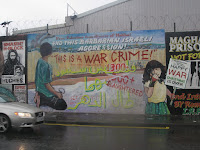The Red Hand of Ulster is a brilliant myth with relevance in both Catholic and Protestant communities. The symbol of the Red Hand flying on flags (whether on gold fabric for the Ulster Province of Ireland or white fabric for the place Ulster has in the United Kingdom), represents this northern territory of the island and rejoices in its myths and history and progress. Whether you define it as 6 counties or 9, the culture of this space does not change and the self-definition of an individual or a place is not infringed upon.
I guess what I love about Ulster is that you can see it and define it however you like! You want to be British? OK! Are you Irish, that's OK too! And now a days, you can be both (or neither).
The Ulster Covenant certainly stands for something strongly loyalist. Signed 28 September 1912 by nearly 1/2 a million people, it reads
we, whose names are underwritten, men of Ulster, loyal subjects of His Gracious Majesty King George V, humbly relying on the God whom our fathers in days of stress and trial confidently trusted, hereby pledge ourselves in solemn Covenant, throughout this our time of threatened calamity, to stand by one another in defending, for ourselves and our children, our cherished position of equal citizenship in the United Kingdom, and in using all means which may be found necessary to defeat the present conspiracy to set up a Home Rule Parliament in Ireland.The women's covenant is slightly different but encompasses the same sentiment (the disparity in covenants for men and women is an issue for another time...).
This is powerful language, it inspired marches and riots and hateful feelings and activity. It encompasses a lot of things associated with loyalism- the Crown, the United Kingdom, God. However, even further so it diminishes the Home Rule Movement into a subversive 'conspiracy'. It negates any potential for democracy. It threatens 'using all means' to defend that very right.
Next year, on the centenary of the signing of this covenant, I wonder if there can be a movement where the people who feel themselves to belong to Ulster in any form and capacity, sign a new covenant and celebrate a new Ulster Day that will reflect the positive elements of this part of the world. A covenant that breaks down the myths that the Titanic was built by only Protestant shipbuilders. A covenant that is proud of the military sacrifices Ulstermen and Ulsterwomen have made--coming from Protestant, Catholic, and other communities. I wonder if we can all sign a statement that says we are loyal to one another, that we will defend one another and the rights of our children to chose their own identity. That we will benefit from employment opportunities that value skill and education. That our education system will provide equal learning and opportunities for every student, regardless of background! That we will do whatever it takes to have a healthy, happy and successful Ulster that promotes tolerance, welcomes diversity, and sees the true benefits of cooperation. An Ulster that will not ignore sectarianism, that will not empower bigoted politicians, that will not go backwards--but only forwards.
There will be marches and bands and speeches and music, but it will not be of the variety you may well know and remember. Ulster Day 2012 will be neither Orange nor Green. It will not chose to define itself in the limited confines of past memories.
Ulster has the potential to clarify its definition to encompass whatever it sees for itself in the future. From the earliest peoples to Neolithic farmers to Celtic Kingdoms to Vikings to Normans to Ulster Plantation to partition to consociationalism. From invasions and battles to civil war and peace. From myth to history to present. This land has seen many different people, been ruled by many different types of authority.
Change will not stop. It is only right that Ulster embraces these changes and defines itself in a language we can all speak. We, all of us who live here in this wonderful part of the island, are people of Ulster and we deserve a covenant that reflects us all.












